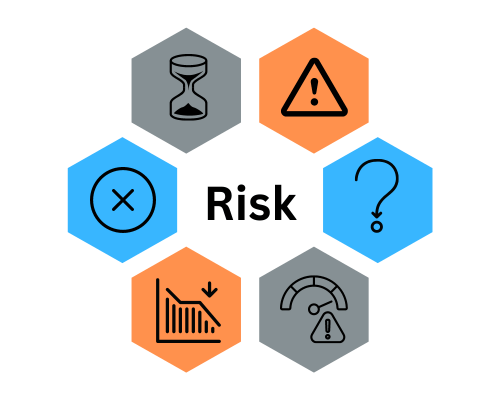Stock market and investing is a high-risk, high-reward game. However, in today’s world, not taking any risk is the biggest risk.
It’s clear that we can’t be profitable or earn high returns without taking any risk. Hence, it’s important for you to know the fundamentals of risk management to become successful in the stock market.
But before understanding risk management, it’s important to know what risk is.
Let’s Dive in
Table of Contents
What is risk?
Risk is the possibility that investors will not produce the desired results or return. Risk includes the potential of losing all your investment or a portion of it.
Every person has a different risk appetite. For example, a high-net-worth individual who is settled in life can take a higher risk than a middle-class person who has just started earning.
The risk-taking ability of a person can also be different age-wise. For example, a young individual can take a higher risk than a person who is above to retire.
Now that you know what is risk, let us now understand the fundamentals of risk management and the complete process of managing risk.
What is Risk Management?
The process of identifying, analyzing, and reacting to risks that are prominent to a business is referred to as risk management. Managing risk effectively involves taking action timely rather than responsively to influence future outcomes to the greatest extent possible.
As a result, good risk management has the potential to mitigate both the probability of a risk happening and its consequences.
Risk management framework
Risk management frameworks are made to accomplish a lot more than identify current risks. An effective risk management framework should also account for challenges and forecast their impact on your investments.
The outcome is a decision between taking risks or ignoring them. The risk tolerance thresholds that an individual has already established for itself determine whether risks are accepted or rejected.
The risk management frameworks can be used to encourage other risk mitigation processes if you establish risk management as a systematic and sustained process with the goal of detecting and addressing risks.
They consist of financial planning; cost management; strategizing; and organizing. Due to the emphasis on risk management, you will typically not encounter many risks in such a scenario.
Now you might be wondering, how do we build a framework and execute the same?
Don’t worry, we’ve got you covered. We are going to study some of the most effective risk management techniques to build a framework.
But before that, it is important to know a complete risk management process to properly execute the framework that you have built.
Risk Management Process
1. Identifying risks
Brainstorming is the key technique used to identify risks. You must try to gather all the information about the investment you have or the company you are going to invest in.
The following step is to prioritize each of the identified risks. Prioritization makes sure that investments dealing with higher and more severe risks are addressed effectively.
2. Assessing the risks
The next step is to assess the problem and the risks identified in the previous step. Measure the intensity of the risk. Examine whether the risk is for the long term and short term and as yourself, this question “What ended up causing such an uncertainty and how might it affect the market?”
3. Response
Now it’s time to take action based on the research and assessment you did. You have to make changes in your investments and make your investments accordingly. As mentioned before, take risks based on your risk appetite.
After understanding the complete risk management process, I know you might be curious to know some of the most effective risk management techniques to build a perfect framework.
Lets get started,
Risk management techniques
There are several risk management techniques to manage risk efficiently. Lets have a look at some :
1. Portfolio Diversification
Portfolio diversification is the technique of investing your capital in a variety of asset classes to reduce the overall risk. The main goal of diversification is to reduce investment risk, particularly non – systematic risk. So, if one asset class faces a downfall, the other maintains profits and balances your portfolio.
2. Hedging
Hedging is a management technique that is extremely important for you to understand for reducing risks. This technique protects your money from being subjected to a threatening condition that might cause the loss of an asset.
Hedging, nevertheless, does not guarantee that your investments won’t experience any value loss. Instead, if in case of any mishap occurs, gains from another asset will counterbalance the damage.
3. Insurance
Insurance is a great way to reduce losses by managing your risks. However, insurance policies cannot be found for every asset class. For example, stocks don’t have insurance, but you can surely take insurance for your house, machines, etc. Remember, investment is not restricted to the stock market only.
Final words
Countless risks can negatively impact the growth and success of our investments. Therefore, it is essential to know the fundamentals of managing risk and how these principles can be applied to reduce the impact of risks on our investments.
I hope you guys, enjoyed reading the article, let me know in the comments below if you have anything to add.
Believe in Yourself

